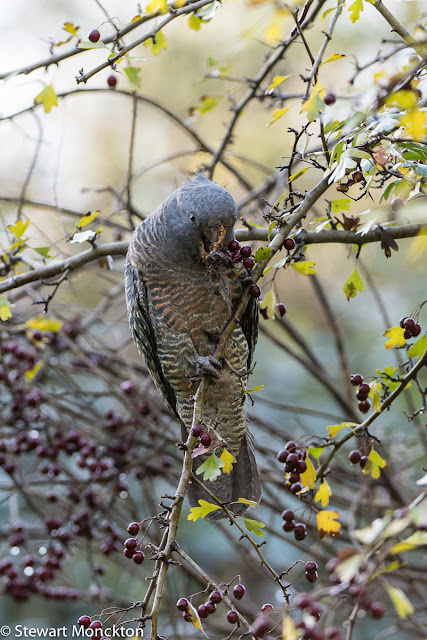I went for a walk around Banuyle Flats (about 25 minutes from my house) this Sunday, which was great way to spend a few hours out of the house. It seemed that a few other people had had the same idea as well, but it was nice to be able to chat (at a safe distance!) to a few other birders.
I quickly found a small flock of Gang Gang Cockatoos (Callocephalon fimbriatum) feeding noisily and messily on hawthorn berries. From the sound of cracking seeds, I assume that the birds were actually eating the seeds rather than the flesh of the berries.
The Gang Gang can bee seen in the SE of Australia, and will even feed in gardens if there is ample food.
The males here have a red head - although I think the male here is an immature - while the females have a grey head.
As ever you can join in with WBW by clicking on the link below - and also as ever, please feel free to share WBW with other bloggers. SM
I quickly found a small flock of Gang Gang Cockatoos (Callocephalon fimbriatum) feeding noisily and messily on hawthorn berries. From the sound of cracking seeds, I assume that the birds were actually eating the seeds rather than the flesh of the berries.
The Gang Gang can bee seen in the SE of Australia, and will even feed in gardens if there is ample food.
The males here have a red head - although I think the male here is an immature - while the females have a grey head.
As ever you can join in with WBW by clicking on the link below - and also as ever, please feel free to share WBW with other bloggers. SM









An impressive bird Stewart and one I have never seen in person. Thanks for hosting, stay safe and have a great week ahead.
ReplyDeleteThat is one amazing bird. I want to see that one!
ReplyDeleteLovely photos, I do envy you your Australian birds though the Little Owl makes up for what I miss there and in RSA. Stay safe Diane
ReplyDeleteExciting bird, S. Thank you.
ReplyDeleteQuite distinctive plumage and very acrobatic! I looked them up to find the source of its name, such as the sound of their call, but it came from a New South Wales Aboriginal language.
ReplyDeleteHari Om
ReplyDeletegotta love a cockatoo or two... or more! YAM xx
Those males are such show-offs with their bright red heads.
ReplyDeleteBeautiful
ReplyDeleteBeautiful head feathers on the males! Nice photos!
ReplyDeleteFascinating bird!
ReplyDeleteGreat photos!
ReplyDeleteThe female is not as colorful, but still a very pretty bird. I like the delicate pattern of her feathers.
Hope you are having a good week!
Hi Stewart, nice Gang Gang Cockatoo. Very beautiful. You are very lucky to see them so close to your home. Greetings Caroline
ReplyDeleteSeeing them in their natural habitat must be exhilarating, Stewart. All the cockatoos I have ever seen have been in captivity. You are a lucky man that you do what you do and love it, my friend!...:)jp
ReplyDeleteNow that's what you call a natural redhead!
ReplyDeleteFabulous bird. I saw this species quite frequently at the Australian National Botanic Garden in Canberra during my first trip to Australia, but was unsuccessful in 2018.
ReplyDeleteHello Stewart
ReplyDeletethat's a very nice bird, you can only see something like this here in Germany at the zoo or in the zoo, thanks for showing it
Regards Frank
What a unique cockatoo! Very nicely photographed, Stewart.
ReplyDeleteYet another "wish I could see it in person" bird from down under. One day ......